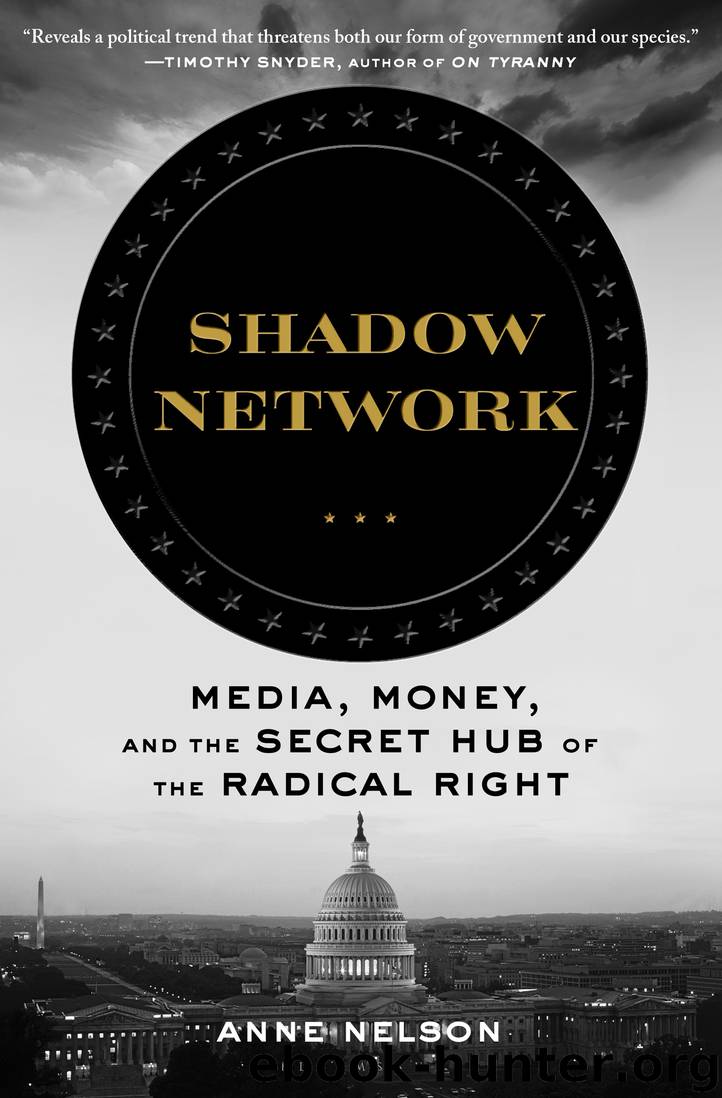Shadow Network by Anne Nelson

Author:Anne Nelson
Language: eng
Format: epub, azw3
Publisher: Bloomsbury Publishing
CHAPTER 11
THE ART OF THE DEAL: NEW YORK, JUNE 21, 2016
The candidate was the problem. Ted Cruz had won the hearts, minds, and purses of the CNP and the Koch network, but as of May 4, 2016, Donald Trump had undeniably won the primaries. Now the shadow network faced a distressing choice: either accept a victory by their nemesis Hillary Clinton, who was running a healthy lead in the national polls—or embrace Donald Trump, the man Ted Cruz had just labeled “utterly amoral” and a “pathological liar,” and the CNP’s Richard Land had denounced as “exceptionally bad.”1
A group of female conservatives, including CNP members Marjorie Dannenfelser and Penny Nance, had sent an “anyone but Trump” letter to Iowa voters, stating, “As women, we are disgusted by Mr. Trump’s treatment of individuals, women in particular.”2 As far as the movement’s key issues were concerned, Trump’s loose-cannon rhetoric had been all over the place; he was on record saying he didn’t care to challenge same-sex marriage, and he was wobbly on abortion.3 His religious credentials were spotty, to put it mildly.4 For a coalition that depended on getting out the fundamentalist vote, these were poor optics indeed.
For George Barna, the taste of victory was turning to ashes. For the past three decades his polls had informed the political campaigns of Christian fundamentalists and the funding strategies of right-wing donor networks. Now, in the spring of 2016, those years of work appeared to be paying off—until they threatened to evaporate.
Barna combined analysis with evangelical zeal. With his neatly trimmed hair and horn-rimmed glasses, he looked like an aging Harry Potter. Besides his polling, Barna produced a stream of books and presented his research in seminars for the faithful. At the Family Research Council’s Values Voter Summit, Barna briefed rooms full of dedicated fundamentalists with chapter and verse on election tactics, including turnout projections, generic ballots, and favorability ratings to apply toward their campaigns.5
Barna claimed that his efforts were all the more successful for taking place, quite intentionally, off the national radar. He boasted that he followed every heartbeat of the “opposition media—the major networks, CNN, MSNBC, the New York Times and the Washington Post,” but what he called “the other side” had little notion of the coalition’s project.6
Barna had every notion of the challenge ahead. The Republicans had held control of both houses of Congress since 2014, with the biggest House majority since World War II.7 This allowed them not just to stymie the Obama’s judiciary appointments in the Senate but also to derail his budgets from the House. The odds were excellent for holding on to the Senate in 2016, thanks to a favorable map for the Republicans. This also would be the case in 2018, and somewhat less so in 2020.8 The polls favored Hillary Clinton to win the popular vote and the Republicans to hold the Senate.9 A Democratic presidency and a Republican Senate would once again stall governance on many fronts, but it could well result in more seats for moderate judges.
Download
This site does not store any files on its server. We only index and link to content provided by other sites. Please contact the content providers to delete copyright contents if any and email us, we'll remove relevant links or contents immediately.
| Anarchism | Communism & Socialism |
| Conservatism & Liberalism | Democracy |
| Fascism | Libertarianism |
| Nationalism | Radicalism |
| Utopian |
The Secret History by Donna Tartt(18813)
The Social Justice Warrior Handbook by Lisa De Pasquale(12126)
Thirteen Reasons Why by Jay Asher(8769)
This Is How You Lose Her by Junot Diaz(6761)
Weapons of Math Destruction by Cathy O'Neil(6116)
Zero to One by Peter Thiel(5662)
Beartown by Fredrik Backman(5575)
The Myth of the Strong Leader by Archie Brown(5404)
The Fire Next Time by James Baldwin(5225)
How Democracies Die by Steven Levitsky & Daniel Ziblatt(5112)
Promise Me, Dad by Joe Biden(5077)
Stone's Rules by Roger Stone(5013)
100 Deadly Skills by Clint Emerson(4824)
A Higher Loyalty: Truth, Lies, and Leadership by James Comey(4822)
Rise and Kill First by Ronen Bergman(4687)
Secrecy World by Jake Bernstein(4619)
The David Icke Guide to the Global Conspiracy (and how to end it) by David Icke(4607)
The Farm by Tom Rob Smith(4423)
The Doomsday Machine by Daniel Ellsberg(4398)
